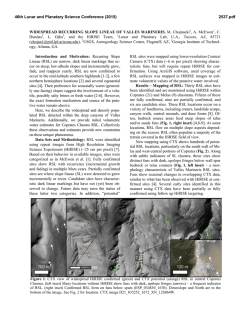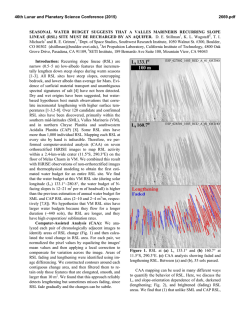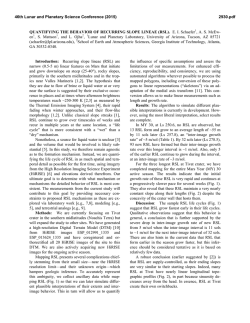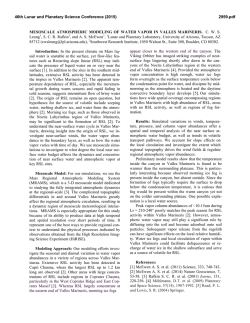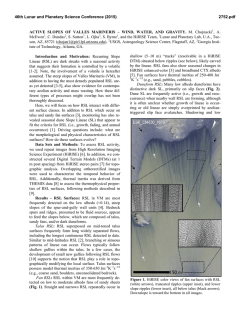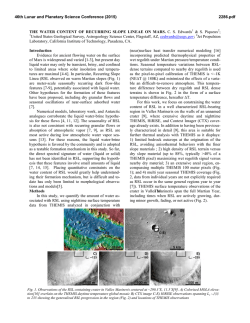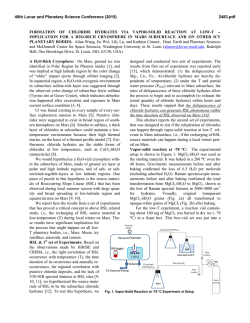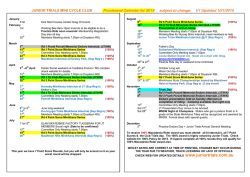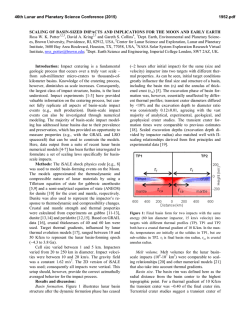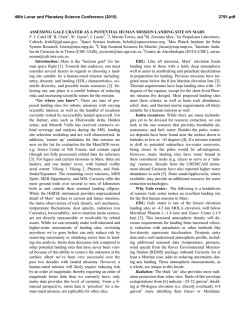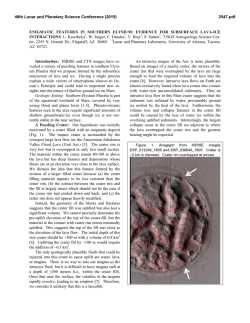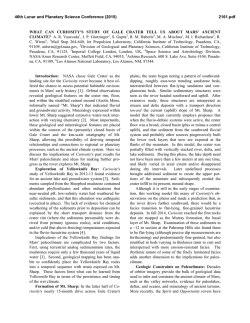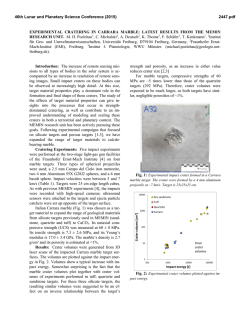
New Constraints on the Locations, Timing and Conditions for
46th Lunar and Planetary Science Conference (2015) 2327.pdf NEW CONSTRAINTS ON THE LOCATIONS, TIMING AND CONDITIONS FOR RECURRING SLOPE LINEAE ACTIVITY ON MARS. C. M. Dundas1, A. S. McEwen2, S. Sutton2, 1U. S. Geological Survey, Astrogeology Science Center, 2255 N. Gemini Dr., Flagstaff, AZ 86001 ([email protected]), 2The University of Arizona, Lunar and Planetary Laboratory, 1541 E. University Blvd., Tucson, AZ 85721. Introduction: Recurring Slope Lineae (RSL) [12] are dark flows found at many locations throughout low and middle latitudes on Mars. Distinctive properties of RSL include slow incremental growth, formation on warm slopes in warm seasons, and annual fading and recurrence. These properties strongly suggest that RSL formation is controlled by a volatile and are consistent with flows of water or brine. However, the source of water is unknown and dry processes cannot be entirely ruled out. When initially reported [1], RSL were only known in the southern mid-latitudes, with a handful of nearequatorial candidates. Activity was reported to begin sometime after LS=245° (late southern spring) and continue into late summer or early fall [1-3]. RSL were subsequently discovered in near-equatorial Valles Marineris, with a seasonality dependent on slope aspect. Within a single 1-km crater, activity was observed to shift to different slopes, following the location of maximum heating. McEwen et al. [2] also noted the presence of one northern mid-latitude RSL site in Acidalia Planitia. Because of the high importance of current surface liquid on Mars for both science and exploration, RSL are being intensively monitored by the High Resolution Imaging Science Experiment (HiRISE), and searches to find new RSL locations are ongoing. Here we report results from ongoing observational campaigns and modeling efforts, providing new information about the locations, timing and conditions for RSL activity. Observations: Location: The equatorial RSL reported by [2] were strongly concentrated in Valles Marineris (VM), with one partially confirmed location in Terra Sabaea. Many more RSL have subsequently been observed in VM [4]. Candidate and likely RSL have also been found at other equatorial locations. A crater at 8°S, 86°E in Tyrrhena Terra exhibits the best candidates, with clear incremental growth and fading, but has only been monitored for half of a Mars year, so annual recurrence cannot yet be tested. Slope activity with some similarity to RSL has also been seen in several steep craters in Meridiani Planum. Because of the high importance of potential RSL, we have also conducted an extensive survey of slopes in Gale crater [5]. Numerous lineations occur on slopes, and some candidate changes have been identi- fied. To date, none exhibit the full set of characteristics of RSL; the best candidates, ~50 km east of the Curiosity rover, appeared and grew as shown in an early HiRISE image pair (Fig. 1) during late northern spring, but subsequently faded and have not recurred in subsequent Mars years [5]. Figure 1: Candidate lineae in Gale crater (HiRISE image PSP_008437_1750). Arrows show examples. Image stretched to enhance contrast. An extensive survey of Acidalia Planitia has revealed that the single example reported by [2] was not an outlier. Three confirmed locations are now known, along with eight likely locations exhibiting incremental growth. All locations occur on steep crater walls, and typically have only a small number of lineae (often less than ten), in contrast to the most prominent locations in the southern hemisphere. Timing: Most southern-highland RSL activity occurs in southern summer, and begins in late spring. However, we have now observed that on the central peak of Hale crater (35.7°S, 323.5°E), RSL activity apparently begins much earlier than expected, as new RSL were observed to be present at LS=194° (Fig. 2). This may reflect some unique characteristic of the Hale crater RSL, since initial indications of Mars Year 32 activity are presently being seen at the expected time shortly before LS=270°. (Horowitz crater, at a latitude similar to Hale, also exhibits some possible activity with anomalous timing [6].) The seasonality of RSL of Acidalia Planitia is not the mirror image of the typical southern highlands. RSL of significant length were observed at some locations very early in southern spring. At the bestmonitored location, RSL were faded at LS=325° but initiated and reached ~90% of their final length by 46th Lunar and Planetary Science Conference (2015) 2327.pdf LS=8°, with slow growth continuing into mid-northern summer. strongly correlated with solar heating, but is somewhat more extensive than previously known. Figure 2: RSL in Hale crater at LS=194° (HiRISE image ESP_038073_1440). Image stretched to enhance contrast. Insolation Conditions: Because of the strong correlation between RSL and warm slopes, we have conducted modeling of the lighting conditions associated with RSL activity. The initial objective was to test the possibility that RSL could form by rapid heating of nocturnal frost, similar to a process proposed for midlatitude gullies [7]. Frost has been observed to form in equatorial regions [8], and to migrate diurnally at high latitudes [9]. Some RSL source locations do experience sudden morning heating, but it is unlikely that it is sufficient to overcome latent heat loss and produce melting [cf. 10], and other locations do not experience the same dramatic rise in insolation. Related modeling, however, reveals one possible correlation with RSL. At many locations, RSL source areas are associated with either the last (local) shadows of the morning or the first of the evening (Fig. 3). RSL are usually found on steep rocky slopes, so this association is not entirely surprising. However, it does suggest an additional hypothesis for the source of water in RSL. The first and last shadowed locations in an area will each, at some point during the day, be colder than their surroundings, and could be cold traps for transient concentrated nocturnal frost. Although the insolation modeling suggests that such frost is unlikely to melt directly, it could provide locally enhanced humidity to drive deliquescence or even deposit subsurface ice, and the very shallow subsurface may be a favorable location for melting because of the effects of a lag on evaporation rates [11]. It remains to be determined whether this process can supply sufficient water [4]. Discussion: Ongoing campaigns are providing a more comprehensive view of RSL activity. Although the southern mid-latitudes and Valles Marineris remain the sites of the most concentrated RSL, they occur at other equatorial locations and in the northern midlatitudes. The seasonal occurrence of RSL remains Figure 3: Model of shadowing in Palikir crater at 7:30 AM, LS=290°, with RSL source locations from HiRISE image PSP_005943_1380 sketched in red. RSL source locations correlate well with the last shadowed locations of the morning. Illumination is from the right, and the lower left is downslope. These ongoing observational campaigns are providing the data needed to constrain models of RSL formation. Additionally, as RSL may pose planetary protection concerns [12], high-resolution monitoring across multiple seasons is needed when steep slopes occur near candidate landing sites. Acknowledgements: This work has been funded by the Mars Reconnaissance Orbiter Project and by Mars Data Analysis Program grant NNX13AK01G. References: [1] McEwen A. S. et al. (2011) Science, 333, 740-744. [2] McEwen A. S. et al. (2014) Nat. Geosci., 7, 53-58. [3] Stillman D. E. et al. (2014) Icarus, 233, 328-341. [4] Chojnacki M. C. et al. (2015), this conference. [5] Dundas C. M. and McEwen A. S., Icarus, in revision. [6] Ojha L. et al. (2014) Icarus, 231, 365-376. [7] Hecht M. H. (2002) Icarus, 156, 373-386. [8] Landis G. A. et al. (2007) LPSC XXXVIII, Abstract #2423. [9] Cull S. et al. (2010) JGR, 115, doi: 10.1029/2009JE003410. [10] Ingersoll A. P. (1970) Science, 168, 972-973. [11] Farmer C. B. (1976) Icarus, 28, 279-289. [12] Rummel J. D. et al. (2014) Astrobiology, 14, 887-968.
© Copyright 2025
